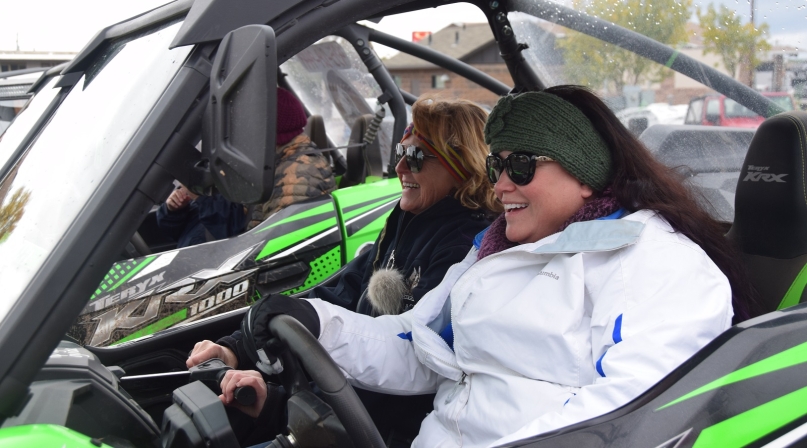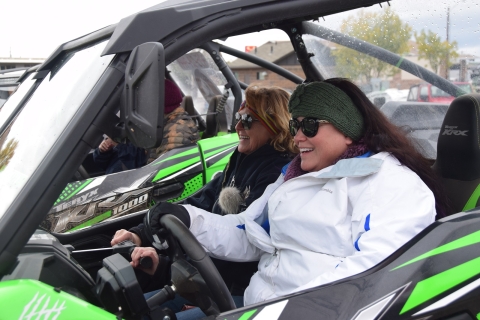Western county officials face mounting challenges, declining resources

Key Takeaways
Under welcome rainy skies, county officials from parched and wildfire-threatened counties met earlier this month in Salt Lake County, Utah for the 2021 Western Interstate Region Conference, joined by NACo’s Rural Action Caucus Symposium.
The conference, Oct. 13-15, was the first in-person meeting for the groups since 2019, and while the pandemic that forced cancelation of the 2020 WIR conference in Mariposa County, Calif. figured into meetings and workshops, programming focused on longstanding existential threats unique to the two rural constituencies that largely saw their low population density as a defense against the spread of COVID-19. And the threat posed by continued drought was a constant topic.
“Figuring out how to work with more limited resources with more people has been a huge challenge,” Brian Steed said of Utah’s drought combined with a growing population. Steed is the executive director of the state’s Department of Natural Resources, following a stint at the Department of Interior during the Trump administration.
Watch
“If you’re a Westerner, you’ve faced that challenge as well, and there’s no easy solution for this,” he said. “We’re experiencing conditions where we have less water and more people, and oftentimes the demands for that water are different than they’ve historically been, so water policy has been a really big deal.”
That’s one reason why attendees didn’t mind a little rain in a region that hasn’t seen much. The variety of high profile and relevant speakers, along with trips to visit local wildfire damage, natural gas and oil drilling sites and the facilities made possible by proceeds from that extraction and a hydroelectric plant, kept county officials busy.
Deputy Secretary of the Interior Tommy Beaudreau noted in a video address that the National Interagency Fire Center had been at preparedness levels four or five for 99 days in 2021, the longest stretch on record.
“Wildfire is an ‘always has been’ part of life in the West, but in recent years, we have seen a new normal in extended and more severe wildfire seasons, unprecedented drought and stress on water systems as well as extreme heat,” he said. “The reality, as we all know, is that there is just not enough water in many basins, which means our relationships, strategic thinking and spirit of community that have served us so well over the decades is needed now more than ever.”
Intergovernmental partnerships are necessary
Utah Gov. Spencer Cox (R) praised the initiative county officials take in their intergovernmental relationships and urged them to continue it.
“We take great pride in our efforts to include county governments in the decisions we make that impact your communities and economies,” he said via a video message. “Without your knowledge and input, state governments are failing to fully serve their citizens.”
Cox served as a Sanpete County commissioner earlier in his career.
“County voices aren’t just important in guiding Utah policy, but federal policy as well,” he said. “Not only do laws and regulations coming out of Washington directly impact Utah counties, but with over 60 percent of our state owned by the federal government, their policies have more of an impact here than in Eastern states.
“What might seem like a great idea in Washington, D.C. can have lasting economic impacts on counties here in Utah,” he noted. “Our partners in Washington need to listen to your voice to improve decisions and build trust withing rural communities.”
Speakers returned consistently to the need to pursue active forest management practices in federal forests to both remove potential fuel for forest fires and glean economic benefit from the wood products.
“We target areas that are likely to burn catastrophically,” Steed said. ‘We’ve had some success in that,” along with watershed restoration initiatives that have removed invasive species.
Mary Farnsworth, Intermountain Regional forester with the U.S. Forest Service, told the WIR Board of Directors that the service was working with counties far more than it ever had, and shared stewardship agreements were making that possible.
“Fire knows no boundaries,” she said. “Economic development is something we have to do together. We’ve lost capacity [for fuels treatment] and we need to grow it back in order to move forward.”
Forest Service Chief Randy Moore told an Oct. 15 General Session audience that the attendance at the Forest Service’s first webinar on its guidebook on working with local officials, authored in part by Sublette County, Wyo. Commissioner Joel Bousman, drew more than 300 line officers [forest supervisors], which encouraged Moore about the future of intergovernmental cooperation.
Jim Ogsbury, executive director of the Western Governors Association, presented WGA Chair and Idaho Gov. Brad Little (R)’s “Working Lands, Working Communities” initiative, which will examine the interdependent relationships between Western communities and state and federal land managers, looking at the role local communities play in successful land management.
“It will provide a forum to develop bipartisan strategies to support those Western communities that are seeking to improve land management and mitigate wildfire risk and restore ecosystems,” Ogsbury said.
Down to business
Beaver County, Utah Commissioner Mark Whitney took office as president of WIR during a May WIR Board meeting in Ravalli County, Mont., home to Immediate Past President Greg Chilcott. Malheur County, Ore. Judge Dan Joyce was elected first vice president and Carbon County, Wyo. Commissioner John Espy was elected second vice president.
The WIR Board of Directors voted to approve a change to its bylaws, empowering itself to appoint members to the Wildfire Leadership Council.
NACo will hold a virtual PILT fly-in, meeting with members of Congress, in early November.
The WIR Executive Committee named two Dale Sowards Award winners, recognizing service to public lands counties: Prairie County, Mont. Commissioner Todd Devlin and Piute County, Utah Commissioner Darin Bushman, whose efforts to prepare his county for remote work, well ahead of the pandemic, fueled the Rural Online Initiative with Utah State University (read more about Bushman here).
Devlin has long been known as the county government guru on Payments in Lieu of Taxes and has been involved in NACo’s efforts to reform the system since 2005. It’s an effort in which he’s dived into numbers and resurfaced with an almost-encyclopedic knowledge of the program as he fought to represent less-populated counties in the PILT funding formula.
“NACo and WIR, since that time, have taught me some valuable lessons in life,” he said. “As an advocate for small counties on PILT payments, I assumed and thought. that the thought that I had, was obvious to all counties, that small counties were being treated unfairly and that an immediate change would be fully supported by WIR and NACo.”
That changed on April 30, 2012, when his wife, Susan leveled with him, days before she died.
“Todd, you need help on PILT reform, you can’t do it alone,” she said.
Shortly after, Devlin attended the WIR Conference in Santa Fe County, N.M., where he received a warm welcome from Ron Walter, then a Chelan County, Wash. commissioner and WIR president, who soon made him chairman of the Public Lands Subcommittee on Federal Lands Payments.
“The gesture by Commissioner Walter started a wonderful relationship of care and trust between me and WIR and NACo,” Devlin said. “It all happened because of caring and trusting relationships.”
Though Devlin sees the American Rescue Plan Act framework as a possible PILT formula replacement, he also hasn’t lost sight of the big picture.
“Counties and the people we serve would survive without PILT,” he said. “It would be tough, but we don’t need federal revenue-sharing — we’d survive. But I’m so pleased that what happened in this conference, to make the number one priority access to federal lands — that’s huge. Without it, we would have no constituency to serve.”

Attachments
Yavapai County, Ariz. Recorder Leslie Hoffman and Arizona Association of Counties Executive Director Jen Marson get comfortable behind the wheel of an ATV before starting their trip to Moonshine Arch in Uintah County, Utah. The trip preceded the Western Interstate Region Conference and Rural Action Symposium in Salt Lake County Oct. 13-15. Photo by Charlie Ban
Related News

Senators introduce bipartisan UPGRADE Act to support small and rural public water systems
On December 15, Sens. Lisa Blunt Rochester (D-Del.) and Roger Wicker (R-Miss.) introduced the Unincorporated Partnerships for Grant Resources, Assistance, and Drinking Water Enhancements (UPGRADE) Act (S. 3465), a bipartisan bill that would strengthen federal support for small public water systems and helps unincorporated communities access clean and affordable water.

House reintroduces bipartisan legislation to level playing field for rural communities
House reintroduced the Rural Partnership and Prosperity Act, bipartisan legislation intended to advance economic development in rural counties and overcome barriers to obtaining federal funding and resources.

White House and U.S. Department of Agriculture announce $12 billion in aid to farmers
On December 8, President Trump and U.S. Secretary of Agriculture Brooke Rollins announced a $12 billion farm aid package to help farmers manage market disruptions and rising production costs.
